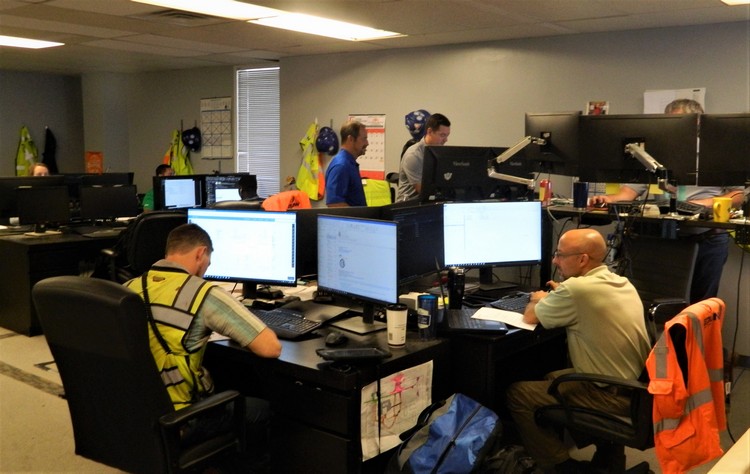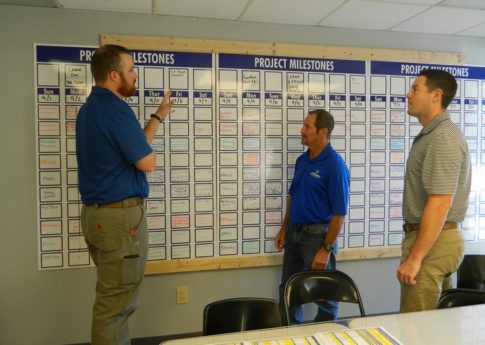
By John Rowlett
One strong indicator of a top-performing construction project is vigorous interaction and communication between the superintendent and the project manager.
While it may be common for the two roles to intersect, the argument here is for a heartier, more cohesive relationship, one in which the two parties are fully in sync and clearly understand each other’s expectations and needs.
Nowadays, owners expect even their most complex projects to be delivered faster, cheaper and with value-added services. In this environment, what’s called for is not an isolationist “I’ll-do-my job; you-do-yours” relationship between superintendent and project manager. To win jobs and meet today’s tougher scheduling and performance standards, our engines have to run much more efficiently.
Optimum performance built on unrestrained communication, integration and interaction between PMs and superintendents is critical in several areas. Among them:
Scheduling. The superintendent must own the project schedule. Absolutely. Unreservedly. The schedule may be compiled initially by the project manager, with the superintendent later reviewing, tweaking as necessary and, ultimately, signing off. Alternatively, the schedule may be prepared by the superintendent and reviewed by the PM. Or the schedule may be prepared jointly. What’s critical is having interplay that brings them eye to eye on how the job will be phased, how it’ll be sequenced and when the buyout and the procurement needs to take place for the critical materials. This is a major outcome of that integration of communication and task.
Subcontractor buyout. In some companies, the purchasing department or the preconstruction group handles subcontractor buyouts. At JE Dunn, we feel it’s critical that the superintendent and project manager together attend subcontractor buyout meetings. A lot of vital information is brought to light there. Project managers can gain advanced insights into costs and price breakdowns. Superintendents can learn how the job is going to be staffed, how it’s going to be sequenced and phased and what the subcontractor production rates need to be. JE Dunn stresses the involvement of superintendents in the buyout process, and maintains that their purposeful, early engagement drives superior outcomes.
Procurement logs. Procurement is a vital part of the job. The materials need to be broken up and phased and shipped in the order that coordinates with the schedule and with the superintendent’s plan. Often the procurement logs are compiled by the project manager, and the superintendent winds up not getting the materials exactly when they are needed. On the best-run projects, the interactions of a bonded superintendent-project manager team can go a long way toward ensuring the materials are procured in the right time frame and in the right order.
Preconstruction. Before bid proposals are developed, before contracts are written, before work begins, making the commitment to integrate operations into the planning process can make all the difference. Reviewing financials, staffing, scheduling, logistics and the project safety and quality plans are among areas of input and involvement the superintendent can use to good advantage before the job starts. The more this happens, the smoother the project is likely to go.

Internal team meetings. On some high-performing jobs, the project manager, superintendent and other members of the internal general contractor team meet daily or weekly to review individual work plans and commitments. This level of communication can stave off all manner of hazards and pitfalls. However, such internal meetings don’t happen nearly as frequently as industry staples like owner-architect-contractor briefings and subcontractor group meetings. Internal team meetings provide excellent opportunities for the PM and the superintendent to sit down and lay everything on the table. The superintendent can say, “OK, I’m having problems with this trade partner; I need you to write them a letter.” Or, “I haven’t been getting my rebar on time, and I need you to call them.” Likewise, the project manager can lean on the superintendent and point out, “It looks like we’re running over on labor costs,” and they can talk about how the job will be staffed going forward. The internal meeting is one more avenue for promoting team communication that can spark dynamic, “what-if” problem solving and innovation.
It is possible, of course, that the suggestion of a more cooperative alliance between PMs and superintendents will get a lukewarm response. Apprehension might stem from worries about the extra time required for additional planning and update meetings, and for jointly reviewing schedules and procurement logs. In our time-crunched lives, that’s a practical concern. Another objection may arise from superintendents and PMs accustomed to working independently and playing a dominant role on projects; they may be most interested in preserving their status or power.
A point of emphasis: Superintendents ought to hold the prevailing hand. Superintendents are closest to the action in the field and more attuned to circumstances that affect the needs of the job. They should, therefore, have the stronger voice in most critical decisions. That said, the goal of a more integrated relationship is less about who’s in charge. PMs and superintendents are equal players — they’re both in charge. The goal here is freer-flowing ideas and information that will better serve clients.
How to make it happen? By selling stakeholders on the undeniable benefits of collaboration: smarter planning and problem solving, and bigger savings in time, money and efficiency.
Superintendents who are open to eliminating walls that inhibit robust communication and collaboration have lots to gain. So, it’s okay for superintendents and PMs to get into each other’s knitting. To integrate. To cross over. To put their heads together more often. Doing so will make them better superintendents. And their projects materially more successful.
John Rowlett is senior vice president – regional director of field operations for JE Dunn Construction.


 Join our thriving community of 70,000+ superintendents and trade professionals on LinkedIn!
Join our thriving community of 70,000+ superintendents and trade professionals on LinkedIn! Search our job board for your next opportunity, or post an opening within your company.
Search our job board for your next opportunity, or post an opening within your company. Subscribe to our monthly
Construction Superintendent eNewsletter and stay current.
Subscribe to our monthly
Construction Superintendent eNewsletter and stay current.